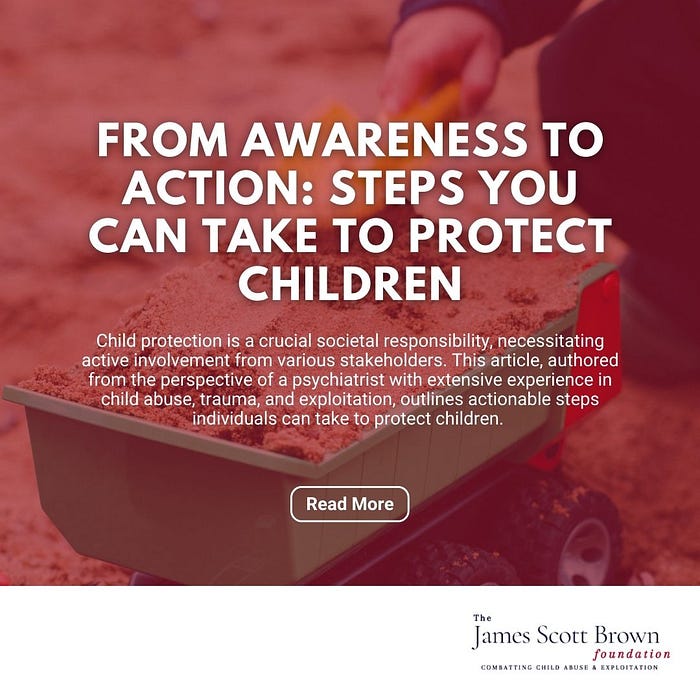From Awareness to Action: Steps You Can Take to Protect Children by James Scott Brown Foundation
by James Scott Brown Foundation

Abstract:
Child protection is a crucial societal responsibility, necessitating active involvement from various stakeholders. This article, authored from the perspective of a psychiatrist with extensive experience in child abuse, trauma, and exploitation, outlines actionable steps individuals can take to protect children. By transitioning from awareness to action, individuals can contribute to a safer and more supportive environment for vulnerable children.
1.Educate Yourself and Others:
Familiarize yourself with the signs of child abuse, neglect, and exploitation (Hawkins & Radcliffe, 2006). Share this knowledge with others to raise awareness, enabling more people to identify and respond to potential cases of maltreatment.
2. Report Suspected Abuse:
If you suspect a child is being abused or exploited, report your concerns to the appropriate authorities, such as child protective services or law enforcement agencies (Mathews & Kenny, 2008). Timely reporting is essential for protecting children and initiating necessary interventions.
3. Support Local Organizations:
Volunteer your time or resources to local organizations working to prevent child abuse, provide support to survivors, and raise awareness about child exploitation (Small, 2011). By collaborating with these organizations, you can contribute to the well-being of children in your community.
4. Promote Safe Environments:
Advocate for the establishment and enforcement of child-safe environments in schools, recreational facilities, and other community spaces (Petrosino et al., 2010). Encourage the adoption of policies and procedures that prioritize child safety, such as background checks for employees and volunteers working with children.
5. Encourage Parental and Caregiver Education:
Support initiatives that promote positive parenting practices and educate caregivers on the risk factors for child abuse and exploitation (Barlow et al., 2006). Informed and empowered caregivers can better protect and nurture their children.
6. Engage in Legislative Advocacy:
Lobby for stronger child protection laws and policies in your jurisdiction (Kingdon, 2011). By advocating for legislative change, you can help create a more robust legal framework to protect children from abuse and exploitation.
7. Foster Open Dialogue:
Promote open communication about child abuse and exploitation within your community, breaking the silence and stigma associated with these issues (Finkelhor, 2009). By fostering dialogue, you can contribute to a culture of support and understanding, where survivors feel empowered to seek help.
Conclusion:
Taking action to protect children is a collective responsibility that extends beyond awareness. By educating oneself and others, reporting suspected abuse, supporting local organizations, promoting safe environments, encouraging caregiver education, engaging in legislative advocacy, and fostering open dialogue, individuals can contribute to the safeguarding of children from abuse and exploitation.
References:
Barlow, J., Johnston, I., Kendrick, D., Polnay, L., & Stewart-Brown, S. (2006). Individual and group-based parenting programs for the treatment of physical child abuse and neglect. Cochrane Database of Systematic Reviews, 3, CD005463.
Finkelhor, D. (2009). The prevention of childhood sexual abuse. The Future of Children, 19(2), 169–194.
Hawkins, R., & Radcliffe, J. (2006). Current measures of PTSD for children and adolescents. Journal of Pediatric Psychology, 31(4), 420–430.
Kingdon, J. W. (2011). Agendas, alternatives, and public policies (2nd ed.). Longman.
Mathews, B., & Kenny, M. C. (2008). Mandatory reporting legislation in the United States, Canada, and Australia: A cross-jurisdictional review of key features, differences, and issues. Child Maltreatment,
Read more at the James Scott Brown Foundation.
Comments
Post a Comment